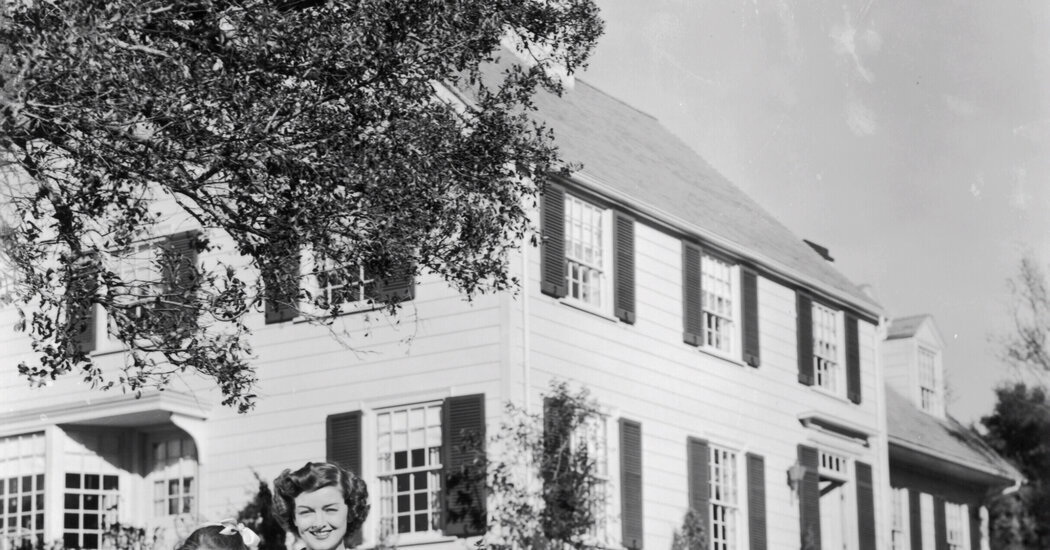
[ad_1]
This year marks the 75th anniversary of one of the most hair-raising horror films ever to hit the big screen: “Mr. Blandings Builds His Dream House.” Adapted from a popular 1946 novel, it tells the story of Jim and Muriel Blandings (Cary Grant and Myrna Loy), a couple climbing the walls in their cramped Manhattan apartment, who buy an old house in Connecticut that becomes a gateway to misery.
On their journey through renovation hell, the couple and their two young daughters encounter a rapacious real estate agent, a rotting foundation, inept and condescending construction workers, fugitive groundwater and an architect who gives in too readily to their baronial ambitions when they have to demolish the wreck and start afresh. Costs mount. Schedules unravel. Tempers hit the stratosphere.
James Sanders, an architect and the author of “Celluloid Skyline: New York and the Movies,” believes the 1948 film maintains its power to trigger anyone who has set out to fix or build a home. But “Mr. Blandings” has earned its place in the cinematic pantheon for another reason.
“It was exactly at this precise time — and captured and epitomized for the ages nowhere better than in this film — that the great American suburban dream of more living space, less density, more open space and greenery took hold in its modern form,” he said.
“Why did cities, and apartments, which just 10 years before represented the epitome of glamour and excitement, suddenly need to be jettisoned for a new vision of American family life?” Mr. Sanders asked.
The New York Times invited him to drill down on that question by revisiting “Mr. Blandings” and the real estate choices it dramatizes. (This conversation has been edited and condensed.)
“Mr. Blandings Builds His Dream House” is a title that is both straight-faced and ironic. The protagonist, an ad executive, ultimately gets the home of his dreams, but building it is a nightmare. Is the family’s move to a suburban colonial a heroic quest or a fool’s errand?
On the one hand, “Mr. Blandings” enjoys cinematic immortality as the ultimate expression of the misery of a major home construction or renovation project. The movie has been remade not once but twice (in 1986 as “The Money Pit,” starring Tom Hanks, and in 2007 as “Are We Done Yet?” starring Ice Cube). It continues to provide the narrative for those endless cable TV home-improvement shows.
But the film is a product of its own time and place, and offers an affirmative view of another ritual that millions of Americans were beginning to undertake in the late 1940s, which was to depart the city for the new car-oriented suburbs that were starting to spring up on the periphery of nearly every American metropolis.
For all the myriad troubles that Cary Grant and Myrna Loy experience, the film never once questions whether jettisoning a two-bedroom apartment on the Upper East Side of Manhattan for a single-family house in the suburbs might be anything other than a genuine dream.
The movie spends many farcical minutes showing what life is like in New York, as Jim and Muriel try to find items in their overstuffed closet and compete to use the mirror in the tiny bathroom. The sequence culminates cringingly in a nook off the kitchen, where Gussie, the Black housekeeper, awkwardly maneuvers to serve the family breakfast, while the older daughter quotes her progressive schoolteacher’s belief that admen like her father are parasites. This is presented as the 1948 equivalent of “woke” talk, but by the end of the movie, Jim has appropriated Gussie’s praise of a brand of ham and turned it into a product slogan that saves his job.
I think the film’s satire is spread fairly wide to mock both the schoolteacher and Jim himself. Actually, the world of advertising was a common target for satire in Hollywood films in the late 1940s, much as network television would be in the 1950s. Hollywood saw both industries as rivals for the public’s attention. So the film’s sly mockery of Jim for having to rely on Gussie (played by the great Louise Beavers) to achieve his breakthrough ad slogan was an industry standard.
By the way, the practice of having live-in maids in urban apartments was quickly coming to an end. Nearly all middle-class apartments in the prewar era included at least one maid’s room, but the modern, smaller, vaguely Miesian apartments being developed in the late 1940s and early 1950s were promoted as efficiently “servantless.” Fast-rising rental costs in the postwar years drove many families to convert the maid’s room in prewar apartments into a child’s bedroom, and changes in the era’s societal structures and expectations made the notion of a live-in maid seem old-fashioned, at least in the city.
How were apartments portrayed cinematically in the decades following “Mr. Blandings,” when American families turned their backs on the city? Would you say that the low point came with Billy Wilder’s “The Apartment” in 1960?
You have to tease out the various kinds of New York apartments portrayed. C.C. Baxter’s walk-up Upper West Side unit in “The Apartment” — the converted upper floor of a former single-family rowhouse — is the kind of starter place that a young, single office worker might have rented before beginning a family, not to be compared to larger, upper-middle-class apartments like the one the Blandingses departed. It’s true that in the 1940s and ’50s, the glamorous penthouses of the 1930s were less prominent in movie New York, though they did make an appearance in films like “How to Marry a Millionaire” (1953), where securing the Sutton Place penthouse that Lauren Bacall, Marilyn Monroe and Betty Grable share was the first assignment in the title’s lesson plan.
In contrast, the “bachelor” apartment — no temporary place, but the well-furnished lair of Manhattan playboys — was a fixture in the filmic city of the 1950s and early ’60s. Think about Frank Sinatra’s pad in “The Tender Trap” (1955) or Dean Martin’s in “Bells Are Ringing” (1960) — spacious and stylish units typically in the East 50s, with panoramic views of the East River, of course.
But as you suggest, the upper-middle-class family apartment was not much in evidence in the postwar years. By the late 1960s and 1970s, big old Manhattan apartments were a kind of albatross. In the protofeminist “Diary of a Mad Housewife” (1970), an eight-room Central Park West apartment is a source of misery for Carrie Snodgress, in part because she and her socially striving husband, played by Richard Benjamin, can’t afford the multiple live-in servants it was intended to be staffed by — so all the upkeep falls on her.
And let us not forget “Rosemary’s Baby” (1968), which turned an apartment in the Dakota into a curse.
Yes, exactly. The dark spirit of the old Victorian place — with its mysterious sounds and closed off-corridors and strange neighbors — refuses to be papered over so easily, until it literally envelops the lives of Guy and Rosemary Woodhouse (John Cassavetes and Mia Farrow) and their baby.
Was there a decisive moment when glamour was restored to the depiction of New York apartment living? (I’m terribly afraid you’re going to say it was with Oliver Stone’s “Wall Street.”)
I would say it was the Reagan-era new money flowing into New York in the 1980s that brought the upper-end Manhattan apartment back into the spotlight: Tom Hanks’s Fifth Avenue duplex in “The Bonfire of the Vanities” (1990), Donald Sutherland and Stockard Channing’s elegant wood-paneled apartment with Central Park views in “Six Degrees of Separation” (1993) — and, yes, the glam Midtown apartment setting of “Wall Street” (1987).
Spilling well into the new millennium, the phenomenon probably reached its peak with the Fifth Avenue penthouse that Mr. Big presents to Carrie Bradshaw in the first “Sex and the City” movie (2008), leading Carrie to exclaim, “I have died and gone to real estate heaven.”
We’re a long way from Jim and Muriel Blandings’s cramped 1940s apartment — or, for that matter, their suburban Connecticut homestead.
Living Small is a biweekly column exploring what it takes to lead a simpler, more sustainable or more compact life.
For weekly email updates on residential real estate news, sign up here.
[ad_2]
Source link






